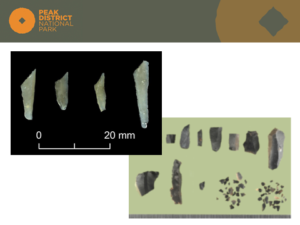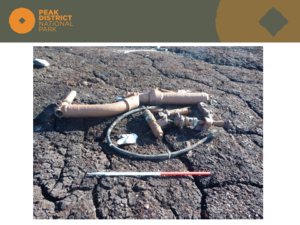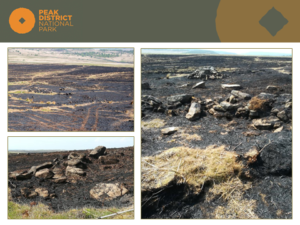Anna Badcock is the Cultural Heritage Manager at the Peak District National Park Authority.
The impact of fires on the heritage of the moors is often neglected and Anna highlighted the effect of a spate of wildfires during the summer of 2018 and spring of 2019 in particular ones at Stalybridge and Big Moor on the edge of the Longshaw Estate.
Rich Heritage Resource
The uplands contain a large variety of rich heritage resources, which can be found on top, within and under the peat soil. Some examples of this are:
Foxholes or weapon pits created as a result of military training in the twentieth century
Starburst shapes on rock faces caused by exploding mortar shells used in firing practice (this particular one is situated near Higger Tor)
An Iron age hillfort near Burbage Edge which also shows traces of bullet holes where the rocks were used for target practice in the last century
Ventilation shafts used by railway tunnels (as seen from Stony Ridge Road)
Millstones quarried in medieval and post-medieval times
Coalmining shafts which were dug by hand particularly in the Goyt Valley
Administrative boundaries between parishes or local authorities marked by carvings and graffiti in the rocks or the establishment of landmarks such as Stanage Pole
Ancient ways that form hollow ways – deeply worn route ways, including those caused by sledge runs used to transport peat from higher plateaus
Bronze age rock art, burial mounds, cairns, stone circles and ancient settlement sites
Stone tools and flint blades used by Mesolithic and Neolithic people moving through the area revealed by the erosion of peat soils on upland edges.
Wild Fire Incidents
In 2018 there were more than thirty fires in the National Park alone. They are generally caused by accidents, carelessness, disposable barbecues or in some cases being started deliberately.
Many of the heritage rich uplands are close to urban populations and easily accessible – this has an obvious impact when considering the incidence of wild fires
The main impacts of fire are a danger to life, devastating effect on vegetation and habitat, loss of air and water quality and reduction in carbon capture.
In June 2018 the fire at Stalybridge caused over ten square kilometres of damage and left burnt and exposed peat over the landscape. As a result, historic items were exposed such as bronze age cairns and even aeroplane wreckage.
At Big Moor a large fire started in summer 2018. This area contains a Bronze Age landscape of great significance and many of the features were exposed as a result of the fire. Photos taken at the time show the fire’s impact.
In addition, there were major fires that year at Merryton Low and on the Roaches in the south of the Peak District. The latter resulted in the loss of a five centimetre depth of peat and released eleven thousand tons of carbon dioxide into the air.
Lessons to be learnt from Fire Incidents
- Documentation and sharing of data to help prepare for future events
- Importance of stabilisation of the dynamic landscape particularly peat and vegetation
- Co ordination of interested parties including universities
- Establishment of volunteer organisations to carry out surveys of areas after fires
- Highlighting the positive benefits of moorland restoration
- Awareness of potential damage caused by fire fighters and the mapping of scheduled monuments which need to be protected
In conclusion Anna stressed that uplands are complex, fragile places and are not just wild and uninhabited environments. In addition, the importance of recognising the multiple interests in the landscapes be they natural, environmental, recreational or heritage so that the relevant bodies can be better prepared for any future incidents.






